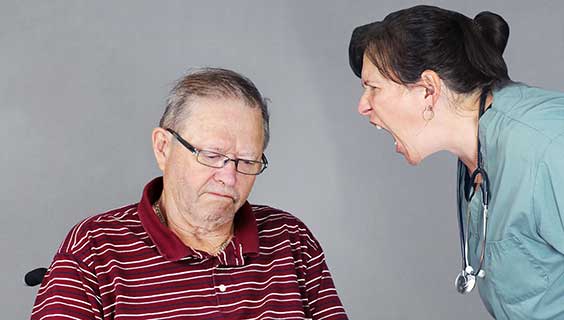When older people are no longer able to care for themselves they must rely on a network of family members, nurses or home caregivers who then become their main source of assistance and care. And unfortunately, abuse of older adults by the very people who they rely on for care is more common than you may think.
According to the World Health Organization, up to one in every six older adults in community care settings has suffered some form of abuse every year. This abuse can be physical, psychological, sexual abuse, neglect, and financial exploitation. In fact, the most common form of abuse is financial exploitation according to the Consumer Financial Protection Bureau.
The biggest challenge is how to identify elder abuse because it is often not reported by the elder victim due to embarrassment, fear, confusion and cognitive impairment such as dementia. Even worse, elder abuse triples the risk of premature death among victims of abuse compared with older adults with similar medical problems who do not experience abuse. Elder abuse is not only wrong, but it is also a national health issue so it is essential for those who are around vulnerable older adults to be able to identify signs of elder abuse and report it to the proper authorities.
What is elder abuse?
Elder abuse can take many forms and includes:
- Financial exploitation such as missing cash, checks or missing belongings
- Neglect such as dirty or unsanitary conditions, bedsores, dehydration and malnutrition, withholding medication and other unexplained or untreated medical conditions
- Physical abuse that results in bodily injuries such as cuts, scratches, bruises or broken bones or the use of restraints or confinement
- Psychological or emotional abuse such as pressuring, bullying and name-calling or threatening to harm the person or their pets.
How can you tell if someone has been abused?
Identifying elder abuse is often difficult. The older person may not identify what has been happening to them as abuse or they may even cover up the signs due to fear, shame or embarrassment. Abuse can sometimes occur without any visible signs or indicators so always be vigilant and follow-up on any suspicions you may have. Unexplained injuries, no matter the severity can also be indications of abuse or domestic violence.
Signs of abuse include:
- Fear
- Anxiety
- Depression
- Withdrawal
- Loss of self-esteem
- Confusion
- Feelings helplessness
Who is at risk for elder abuse?
In general, the older the person, the higher the risk they are for abuse and women appear to suffer more from abuse. Other high-risk groups include people who are socially isolated or need more help with daily living such as people who suffer from dementia or mental illness. In fact, older people who suffer from cognitive difficulties and occasionally act out or become difficult to manage are the riskiest group of all.
Older adults who are at risk for elder abuse include:
- Socially isolated individuals
- Elders who have difficult family relationships or conflict with children or relatives
- Widowed women who become victims of financial exploitation often by men
- Single adults with no partner or spouse are also at risk for financial abuse
- Low-income adults with limited resources to attain professional care are also at risk
Who are the abusers?
Up to 90% of elder abuse and neglect is caused by someone who is well-known to the victim and is often perpetrated by family members, grown children and even husband and wives of the victim. It seems hard to imagine that family members would be responsible for elder abuse until you realize the incredible physical and emotional toll that daily caregiving can take. Daily caregiving can be extremely stressful, demanding and often overwhelming for these family caregivers who are ill-equipped to provide constant care and support for the elder they are taking care of.
Another setting for elder abuse is in nursing homes and long-term care facilities such as violence and verbal attacks by other residents who suffer from cognitive difficulties or bullying and neglect from staff members. Sexual abuse is also more common in nursing homes and long-term care facilities.
How do you report elder abuse?
According to the National Adult Protective Services Association, most cases of abuse, neglect and financial exploitation is severely unreported but there are important steps you can take to report abuse.
If you suspect elder abuse, you must document the signs such as:
- Taking notes of changes in behavior
- Taking photos of any bruises or injuries
- Writing a description of any visible bruises or injuries
- Talking with the victim and documenting what occurred
- Getting a written statement from any witnesses
If you believe abuse may have taken place contact the National Adult Protection Services Association. If you are reporting abuse or neglect that has occurred in a nursing home or long-term care facility then contact your states long-term care ombudsman. Each state has an ombudsman who will help investigate and resolve complaints that occur in nursing homes or long-term care facilities.
Abuse reports can sometimes remain confidential which allows long-term care professionals to report abuse if they suspect it has been committed by a fellow co-worker. This makes it easier to report suspected abuse without fear of retaliation, demotion or potential job loss.
Ultimately, if you suspect elder abuse, you have a moral obligation to report it, stop the abuse and get that person the care that they need. And, if you are a care professional, you may even have a legal obligation to do so. Elder abuse is an under-reported national health problem that is everyone’s responsibility to catch, report and prevent.
For any and all cases of suspected abuse, the first step to reporting is to contact your county Adult Protective Services office (APS). If you witness elder abuse or suspect that abuse or neglect may be happening, no matter the particular circumstances, make the call.
Adult Protective Services in California
Los Angeles County Adult Protective Services
Telephone: (888) 202-4248
24 HR. ABUSE HOTLINE: (877) 477-3646
APS Mandated Reporter Hotline: (877) 477-3646 (M-F, 8:30 to 5 pm)
Area Agency on Aging: (800) 510-2020
![]() Elder Abuse Confidential Report Form (PDF)
Elder Abuse Confidential Report Form (PDF)
Long-Term Care Ombudsman in California
If your aging loved one has experienced abuse or neglect in connection with a care facility, you should also make a report with your local county Long-Term Care Ombudsman.
The toll-free 24-hour crisis line is a good place to start: (800) 231-4024.
You can also get in contact with your local ombudsman program through this county directory at the California Department of Aging.


